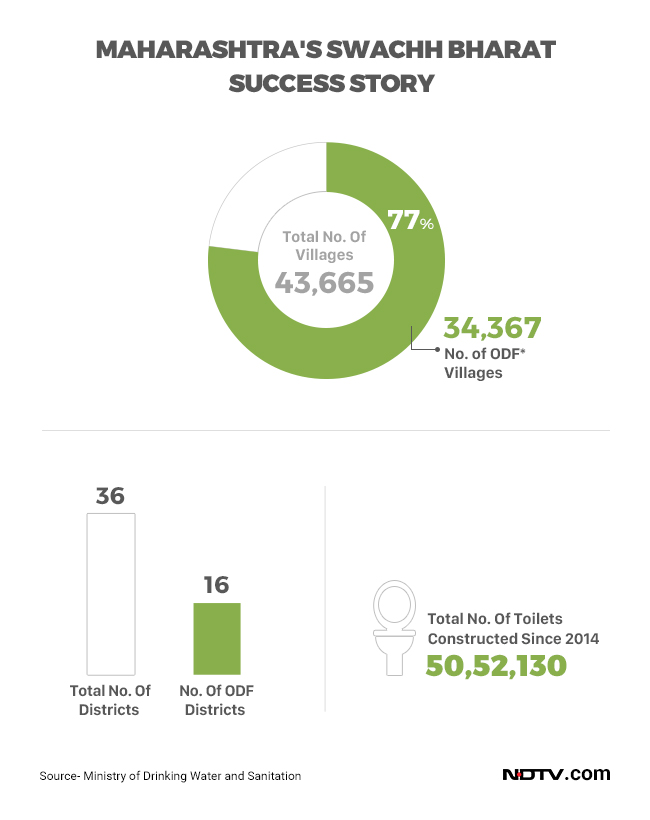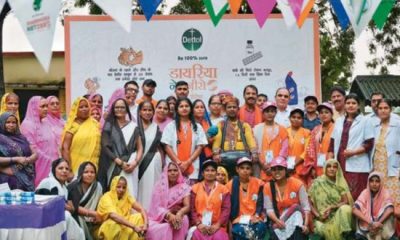Highlights
- Maharashtra tops ODF list, as per Ministry of Sanitation report
- 34,000 villages and 16 districts have become ODF in Maharashtra
- Involving people from communities has been key to the state’s success
New Delhi: When the Swachh Bharat Abhiyan was launched in 2014, due emphasis was given on how it is up to states to ensure that their individual performances in the sanitation sector will shape the national sanitation condition of India. In the four years since the Swachh Bharat Abhiyan was launched, several states have performed well under the Abhiyan, particularly improving their sanitation coverage in rural areas. Maharashtra has done exceedingly well in improving the sanitation status of both the rural and urban areas of the state, a fact cemented by the latest sanitation report by the Union Ministry of Drinking Water and Sanitation.
Maharashtra’s performance in improving rural sanitation has been exemplary and the state today boasts of over 34,000 open defecation free (ODF) villages out of its 43,665 villages, a coverage of over 77 per cent. 16 of the state’s 36 districts have become ODF, with Solapur as the latest entrant in November 2017. Nearly 51 lakh toilets have been constructed in rural Maharashtra since 2014 out of the 5 crore constructed across the country, and their construction is a major reason why the state has been able to attain 97 per cent rural sanitation coverage and is nearly on the verge of becoming completely ODF.
Unlike some states, Maharashtra was committed to the Swachh Bharat Abhiyan from day one and hence has been able to achieve such success within three years of the programme’s launch. The rural areas of the state is slated to go ODF in the coming months and with urban Maharashtra already declared ODF, the state will soon go wholly ODF, said Ruchesh Jaivanshi, Deputy Secretary, Rural Sanitation, Maharashtra.
If the case of Solapur is taken into account, which was declared ODF in November 2017, it becomes easier to understand how involving multiple stakeholders can yield results. In Solapur, special education drives focusing on sanitation were carried out by government schools and students pledged to eradicate open defecation from their households.
Solapur, like other districts from Maharashtra, has involved school students, NGOs and village members to create enough awareness on safe sanitation. The more people get involved, the easier it becomes to inculcate habitual and behavioural changes in people, said Subhash Kamte, Sub-Divisional Officer, Solapur District.
Maharashtra followed the strategy of involving local administrations, as well as volunteers, school students to ensure that sanitation policies were implemented at grassroots for these to translate into success stories. District administrations involved students, self-help groups and NGOs to spread the message of safe sanitation and Swachh Bharat, resulting in continuous building of toilets in rural areas since 2014. It was the state’s approach of involving community members and local change makers that contributed towards the state’s success in the Swachh Bharat Abhiyan.
“The real reason for Maharashtra’s success is that the state never saw the Swachh Bharat objectives as entirely a government initiative. All the district officials across the state were and are still asked to involve local people in their initiatives. This ensures that the focus on behavioural change remains throughout the duration of toilet building in villages, blocks and districts. This also ensures that people need not be coaxed into using toilets that have been built,” said Mr Jaivanshi.
Maharashtra’s final ODF status, if achieved this year will be a landmark one from which several other states can take inspiration. The key to Maharashtra’s success has been involving the community towards their development in the sanitation sector. For states such as Bihar and Uttar Pradesh, which are still struggling to implement Swachh Bharat’s objectives, Maharashtra’s methods could bring in sustained success towards improvement of sanitation.































